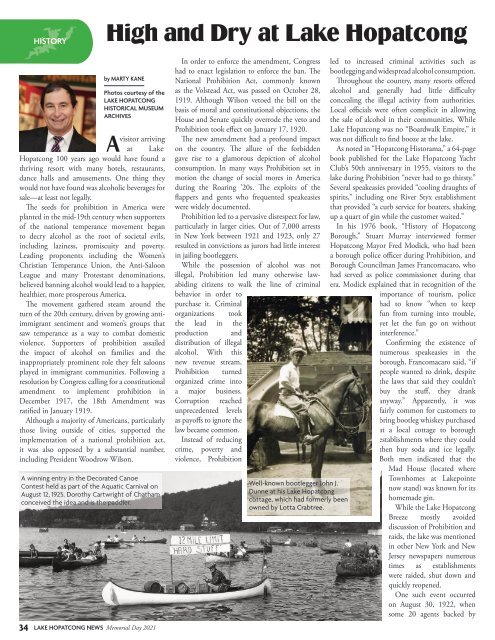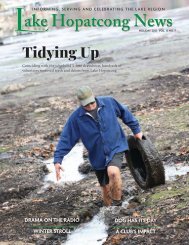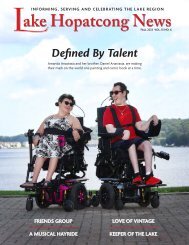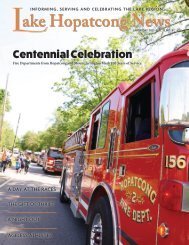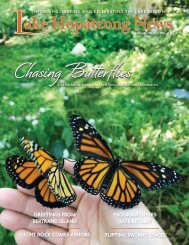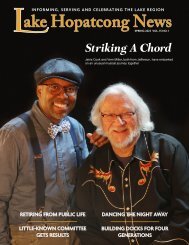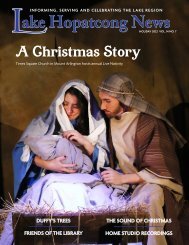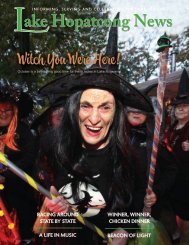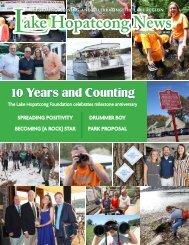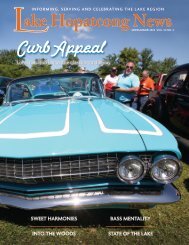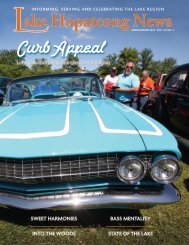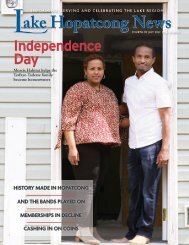Create successful ePaper yourself
Turn your PDF publications into a flip-book with our unique Google optimized e-Paper software.
HISTORY<br />
High and Dry at Lake Hopatcong<br />
visitor arriving<br />
A at Lake<br />
Hopatcong 100 years ago would have found a<br />
thriving resort with many hotels, restaurants,<br />
dance halls and amusements. One thing they<br />
would not have found was alcoholic beverages for<br />
sale—at least not legally.<br />
The seeds for prohibition in America were<br />
planted in the mid-19th century when supporters<br />
of the national temperance movement began<br />
to decry alcohol as the root of societal evils,<br />
including laziness, promiscuity and poverty.<br />
Leading proponents including the Women’s<br />
Christian Temperance Union, the Anti-Saloon<br />
League and many Protestant denominations,<br />
believed banning alcohol would lead to a happier,<br />
healthier, more prosperous America.<br />
The movement gathered steam around the<br />
turn of the 20th century, driven by growing antiimmigrant<br />
sentiment and women’s groups that<br />
saw temperance as a way to combat domestic<br />
violence. Supporters of prohibition assailed<br />
the impact of alcohol on families and the<br />
inappropriately prominent role they felt saloons<br />
played in immigrant communities. Following a<br />
resolution by Congress calling for a constitutional<br />
amendment to implement prohibition in<br />
December 1917, the 18th Amendment was<br />
ratified in January 1919.<br />
Although a majority of Americans, particularly<br />
those living outside of cities, supported the<br />
implementation of a national prohibition act,<br />
it was also opposed by a substantial number,<br />
including President Woodrow Wilson.<br />
34<br />
by MARTY KANE<br />
Photos courtesy of the<br />
LAKE HOPATCONG<br />
HISTORICAL MUSEUM<br />
ARCHIVES<br />
A winning entry in the Decorated Canoe<br />
Contest held as part of the Aquatic Carnival on<br />
August 12, 1925. Dorothy Cartwright of Chatham<br />
conceived the idea and is the paddler.<br />
LAKE HOPATCONG NEWS <strong>Memorial</strong> <strong>Day</strong> <strong>2021</strong><br />
In order to enforce the amendment, Congress<br />
had to enact legislation to enforce the ban. The<br />
National Prohibition Act, commonly known<br />
as the Volstead Act, was passed on October 28,<br />
1919. Although Wilson vetoed the bill on the<br />
basis of moral and constitutional objections, the<br />
House and Senate quickly overrode the veto and<br />
Prohibition took effect on January 17, 1920.<br />
The new amendment had a profound impact<br />
on the country. The allure of the forbidden<br />
gave rise to a glamorous depiction of alcohol<br />
consumption. In many ways Prohibition set in<br />
motion the change of social mores in America<br />
during the Roaring ’20s. The exploits of the<br />
flappers and gents who frequented speakeasies<br />
were widely documented.<br />
Prohibition led to a pervasive disrespect for law,<br />
particularly in larger cities. Out of 7,000 arrests<br />
in New York between 1921 and 1923, only 27<br />
resulted in convictions as jurors had little interest<br />
in jailing bootleggers.<br />
While the possession of alcohol was not<br />
illegal, Prohibition led many otherwise lawabiding<br />
citizens to walk the line of criminal<br />
behavior in order to<br />
purchase it. Criminal<br />
organizations took<br />
the lead in the<br />
production and<br />
distribution of illegal<br />
alcohol. With this<br />
new revenue stream,<br />
Prohibition turned<br />
organized crime into<br />
a major business.<br />
Corruption reached<br />
unprecedented levels<br />
as payoffs to ignore the<br />
law became common.<br />
Instead of reducing<br />
crime, poverty and<br />
violence, Prohibition<br />
Well-known bootlegger John J.<br />
Dunne at his Lake Hopatcong<br />
cottage, which had formerly been<br />
owned by Lotta Crabtree.<br />
led to increased criminal activities such as<br />
bootlegging and widespread alcohol consumption.<br />
Throughout the country, many resorts offered<br />
alcohol and generally had little difficulty<br />
concealing the illegal activity from authorities.<br />
Local officials were often complicit in allowing<br />
the sale of alcohol in their communities. While<br />
Lake Hopatcong was no “Boardwalk Empire,” it<br />
was not difficult to find booze at the lake.<br />
As noted in “Hopatcong Historama,” a 64-page<br />
book published for the Lake Hopatcong Yacht<br />
Club’s 50th anniversary in 1955, visitors to the<br />
lake during Prohibition “never had to go thirsty.”<br />
Several speakeasies provided “cooling draughts of<br />
spirits,” including one River Styx establishment<br />
that provided “a curb service for boaters, shaking<br />
up a quart of gin while the customer waited.”<br />
In his 1976 book, “History of Hopatcong<br />
Borough,” Stuart Murray interviewed former<br />
Hopatcong Mayor Fred Modick, who had been<br />
a borough police officer during Prohibition, and<br />
Borough Councilman James Francomacaro, who<br />
had served as police commissioner during that<br />
era. Modick explained that in recognition of the<br />
importance of tourism, police<br />
had to know “when to keep<br />
fun from turning into trouble,<br />
yet let the fun go on without<br />
interference.”<br />
Confirming the existence of<br />
numerous speakeasies in the<br />
borough, Francomacaro said, “if<br />
people wanted to drink, despite<br />
the laws that said they couldn’t<br />
buy the stuff, they drank<br />
anyway.” Apparently, it was<br />
fairly common for customers to<br />
bring bootleg whiskey purchased<br />
at a local cottage to borough<br />
establishments where they could<br />
then buy soda and ice legally.<br />
Both men indicated that the<br />
Mad House (located where<br />
Townhomes at Lakepointe<br />
now stand) was known for its<br />
homemade gin.<br />
While the Lake Hopatcong<br />
Breeze mostly avoided<br />
discussion of Prohibition and<br />
raids, the lake was mentioned<br />
in other New York and New<br />
Jersey newspapers numerous<br />
times as establishments<br />
were raided, shut down and<br />
quickly reopened.<br />
One such event occurred<br />
on August 30, 1922, when<br />
some 20 agents backed by


